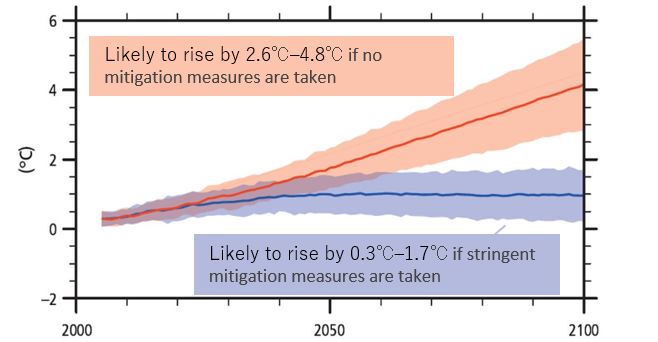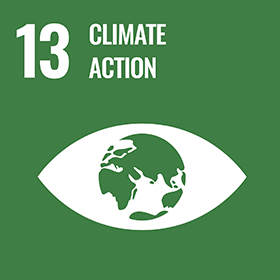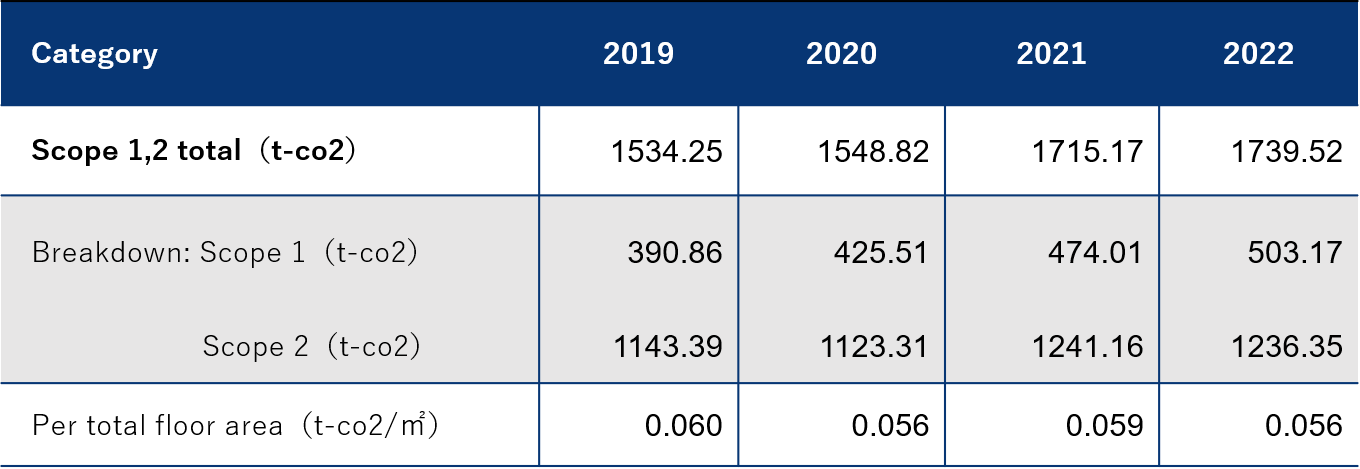Investor Relations


The Task Force on Climate-related Financial Disclosures (TCFD) was formed in 2015 by the Financial Stability Board (FSB) at the request of the Group of 20 (G20) to provide disclosure standards for climate-related information and to inform financial institutions. TCFD recommendations require companies to establish climate change governance systems, conduct scenario analyses based on multiple climate-related scenarios, and disclose business risks and opportunities presented by climate change that were identified in the analyses.
In addition to endorsing the TCFD recommendations, we will identify and analyze the impacts of climate change-related risks and opportunities on our business and make appropriate climate-related disclosures.
Climate change caused by global warming has impacted our lives and nature's ecosystems in many ways.
The Fifth Assessment Report by IPCC*1 projects that, relative to the end of the 20th century (1986–2005), the global mean temperature at the end of the 21st century (2081–2100) is likely to rise by 2.6℃–4.8℃ (the red band of the chart) if effective mitigation measures are not taken, or 0.3℃–1.7℃ (the blue band) even with stringent mitigation measures.
We believe that extreme weather events such as typhoons, floods, and storm surges will intensify due to rising temperatures in the future, threatening people’s livelihoods and resulting in a further drop in birthrates and a decline in the population.

Source: IPCC AR5 SYR SPM Fig. SPM.6
*Comments added by Poppins
To curb rising temperatures, the development of environmentally friendly technologies and, to that end, the participation of women in STEM fields*2 will be indispensable.
As described in Target 13.3 of the SDGs, human development aimed at a sustainable and caring society for children through education is also important.

Improve education, awareness-raising and human and institutional capacity on climate change mitigation, adaptation, impact reduction and early warning
Based on our mission of “supporting working women through the highest standard of Edu-care and elderly care services,” we have been providing comprehensive services to support working women that include the following: a babysitter service, which is our founding business; a nursery service that provides for the operation of government authorized and government certified nursery schools and corporate nurseries, which also offer SDGs education, after-school facilities, and international schools; an elderly care service that provides in-home care; a household chore support service that supports people of various lifestyles, such as dual-income households, elderly households, and single-person households; and training services for nursery teachers and caregivers.
To maintain a world in which healthy living can be attained by everyone, from children who will cultivate the future in which they thrive globally to those who laid the foundations of Japan and created our past and working women, we will consider what we can do against climate change and contribute to its mitigation.
*1 IPCC: The United Nations Intergovernmental Panel on Climate Change. Its purpose is to comprehensively assess climate change caused by human activity and its impact, adaptation, and mitigation options from scientific, technical, and socioeconomic perspectives.
*2 STEM fields: A collective term used to group the four academic disciplines of science, technology, engineering, and mathematics. While the advancement of these fields is deemed essential for developing environmentally friendly technologies, a gender gap has been pointed out due to low female participation.
We have established the Sustainability Committee, with the director in charge of corporate planning as chair, to promote group-wide responses to sustainability issues that include climate change. The Committee meets three to four times a year in principle to discuss and consider basic policies and critical matters concerning sustainability issues.
The Committee reports what was discussed at the meetings to the Board of Directors once a year in principle, while the Board of Directors deliberates and decides response policies and measures for matters deemed to have a material impact on business activities and finance.
We also have a Diversity & Inclusion (D&I) Promotion Committee in place to achieve our aim of becoming a leading company in solving the social issue of supporting working women by making our organization a place where everyone can play an active role in their own way.
Going forward, the Sustainability Committee and the D&I Promotion Committee will work together to achieve continuous corporate value growth while responding to societal changes.

The TCFD recommends conducting a scenario analysis based on multiple climate scenarios to consider the impacts of climate change on business. Accordingly, we conducted an analysis to formulate and consider strategies that address uncertainties.
We carried out the following scenario analysis to consider how we should respond and contribute to the effect of climate change on working women by comprehensively examining the impact not only on our Group but also on working women, who are our target clients.
In this scenario analysis, we made qualitative and quantitative considerations based on the 1.5℃ scenario (and partially on the 2℃ scenario), which assumes the implementation of more ambitious climate action to achieve decarbonization, and the 4℃ scenario, which assumes the implementation of no climate action exceeding those currently in place, resulting in more severe extreme weather events. In addition to the impact as of 2050, our carbon neutrality target year, we have also analyzed the effect as of 2030, the target year of the SDGs.
A scenario in which the rise in average temperatures by 2100 is less than 1.5℃ relative to the pre-industrial period.
More stringent policies and regulations than are currently in place will be imposed to achieve carbon neutrality and curb climate change issues.
[Referenced scenarios] IEA Net Zero Emissions by 2050, IEA Sustainable Development Scenario, IPCC RCP2.6
A scenario in which the rise in average temperatures by 2100 is 3.2℃–5.4℃ (approx. 4℃) relative to the pre-industrial period.
No aggressive policies or regulations to mitigate climate change issues will be imposed, and more severe extreme weather events will become pronounced.
[Referenced scenarios] IEA Stated Policies Scenario, IPCC RCP8.5
The scenario analysis has revealed that damage to our business sites due to intensified extreme weather events is assumed to be a significant risk in both the 1.5℃ and 4℃ scenarios. However, as we have been creating business sites with reference to hazard maps to reduce physical damage, we have deemed that the assumed damage can be kept to a minimum and will not significantly impact our business management. We will continue to create business sites with BCP in mind and ensure the sites are environmentally friendly by using environmentally friendly equipment and materials.
The analysis also assumed that transitioning to a decarbonized society would lead to changes in working women’s workstyles and forms of employment.
As we offer extensive services to empower women, we expect an improvement in social contribution and an increase in revenue opportunities.
Our group will continue to contribute to curbing climate change through our business activities and strive to become a leading company in solving the social issue of supporting working women.

| Entry | Definition |
|---|---|
| Long-term | Expected to occur in 11–30 years’ time |
| Medium-term | Expected to occur in 4–10 years’ time |
| Short-term | Expected to occur in 0–3 years’ time |
| Entry | Definition |
|---|---|
 |
Expected impact of more than 100 million yen |
 |
Expected impact of 10–100 million yen |
 |
Expected impact of less than 10 million yen |
 Opportunity
Opportunity
 Risk
Risk
 Both risk and opportunity
Both risk and opportunity


*Illustration of risk items analyzed quantitatively

The school adopts an environmentally friendly wooden architecture, which emits less GHG than a steel-framed structure. Despite temperatures in Karuizawa, Nagano Prefecture, dropping below freezing in the winter, the school’s design that features large windows installed throughout the building to allow abundant sunlight to enter during the day results in excellent heat retention properties, requiring no heating even during the winter.

Through the “SDGs for Children” education in partnership with joint research with Project Zero of the Harvard Graduate School of Education, we raise children’s awareness of climate change and environmental issues to foster talents who can innovate to solve social issues.
At our nursery schools, LED lights are installed in newly established schools and replacing old ones in existing schools according to repair plans. We also promote efforts to save electricity by enhancing air conditioning efficiency and installing double glazing and heat-insulating material. Water-saving toilets are also being adopted.
We only allow commuting by car or motorbike in rural areas where public transport is unavailable and keep a record of such employees.
In anticipation of more severe disasters due to climate change, we will cooperate and discuss with local governments so that we can offer our facilities to local residents as shelters in the event of a disaster.
We manage climate change-related risks at the Sustainability Committee.
The Sustainability Committee identifies climate change-related risks to group companies and conducts qualitative and quantitative assessments based on the likelihood of occurrence and the scale of financial impact. We also categorize risks associated with new initiatives and risks such as material changes in the external environment as “key risks.” The Board of Directors deliberates and determines response policies and measures against the risks identified as key risks.
As for other risks or matters that require short-term and urgent responses, including climate change-related risks, the Operation Risk Management Committee deliberates responses and gives instructions to the relevant departments.
Responses against climate change-related risks instructed by the Operation Risk Management Committee due to their urgency will be monitored by the Sustainability Committee for their progress and whether the instructions were appropriate and in line with our policy.
Risks identified and assessed by the Sustainability Committee and the Operation Risk Management Committee are reported to the Board of Directors once a year, in principle, for company-wide risk management.

We adopt GHG (greenhouse gas) emission reduction targets as a metric to manage our progress in addressing climate change.
To realize a sustainable society, we will consider medium-to long-term strategies and initiatives in line with the 1.5℃ target set out in the Paris Agreement and with our aim of achieving carbon neutrality by 2050.

2030
50% reduction
vs. 2021
(Per square meter of
total floor area)
2050
Achievement of carbon neutrality
Target locations: Offices and sites including those of group companies (excludes locations occupied as a tenant)
Scope 1: Direct GHG emissions from company-owned and controlled sources (e.g., fuel combustion, industrial processes)
Scope 2: Indirect emissions associated with the consumption of purchased of electricity, heat, and steam

